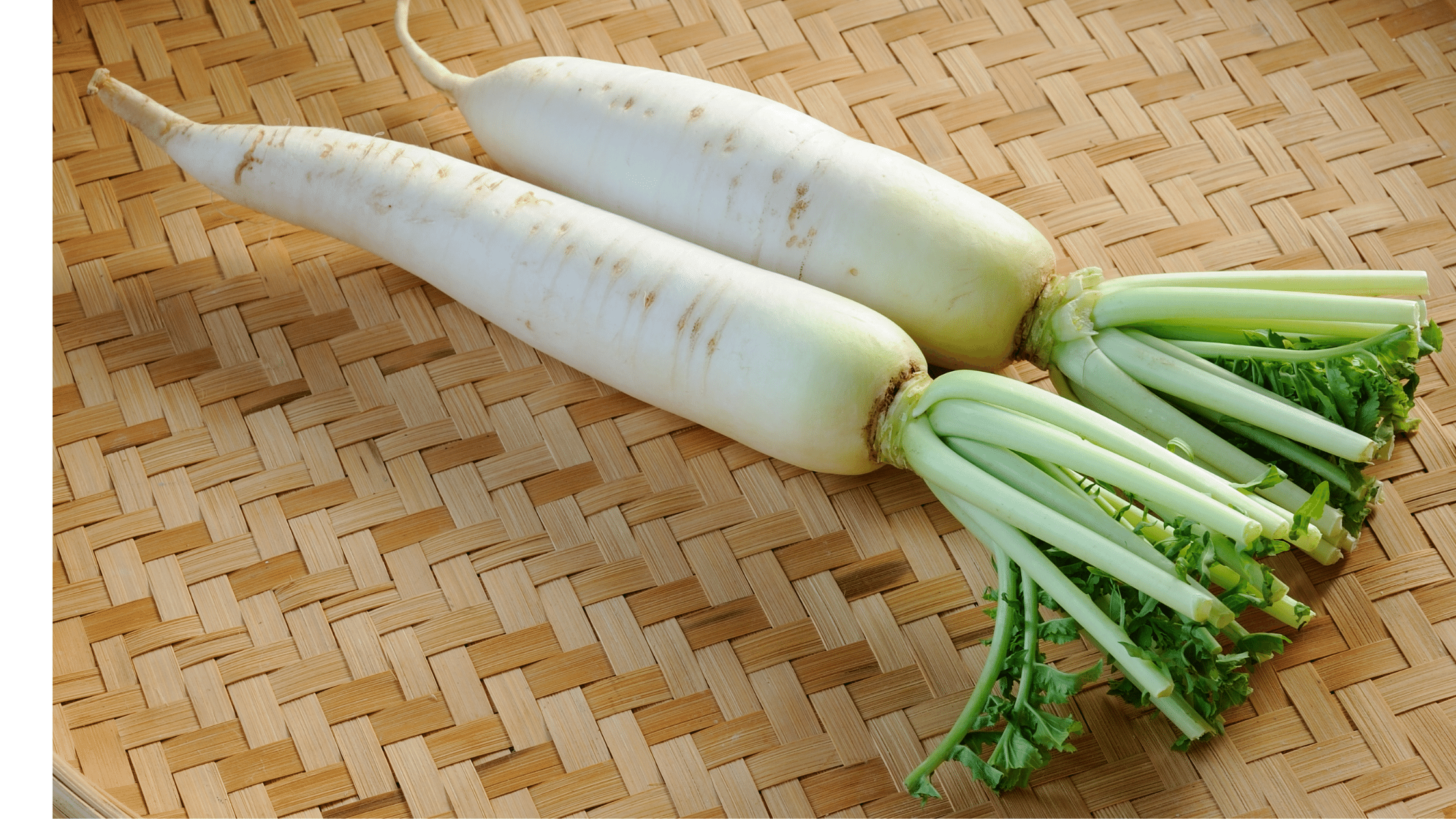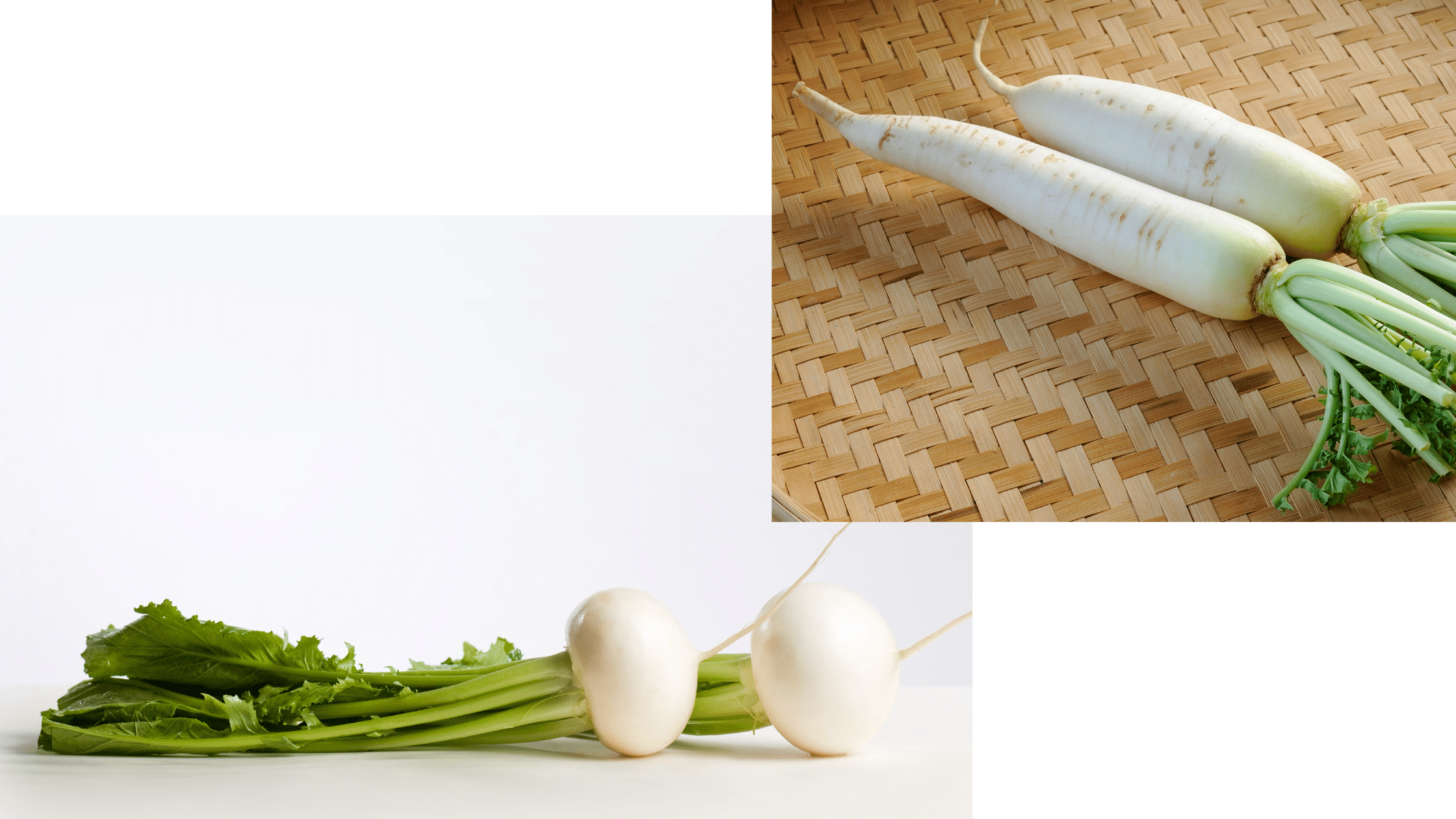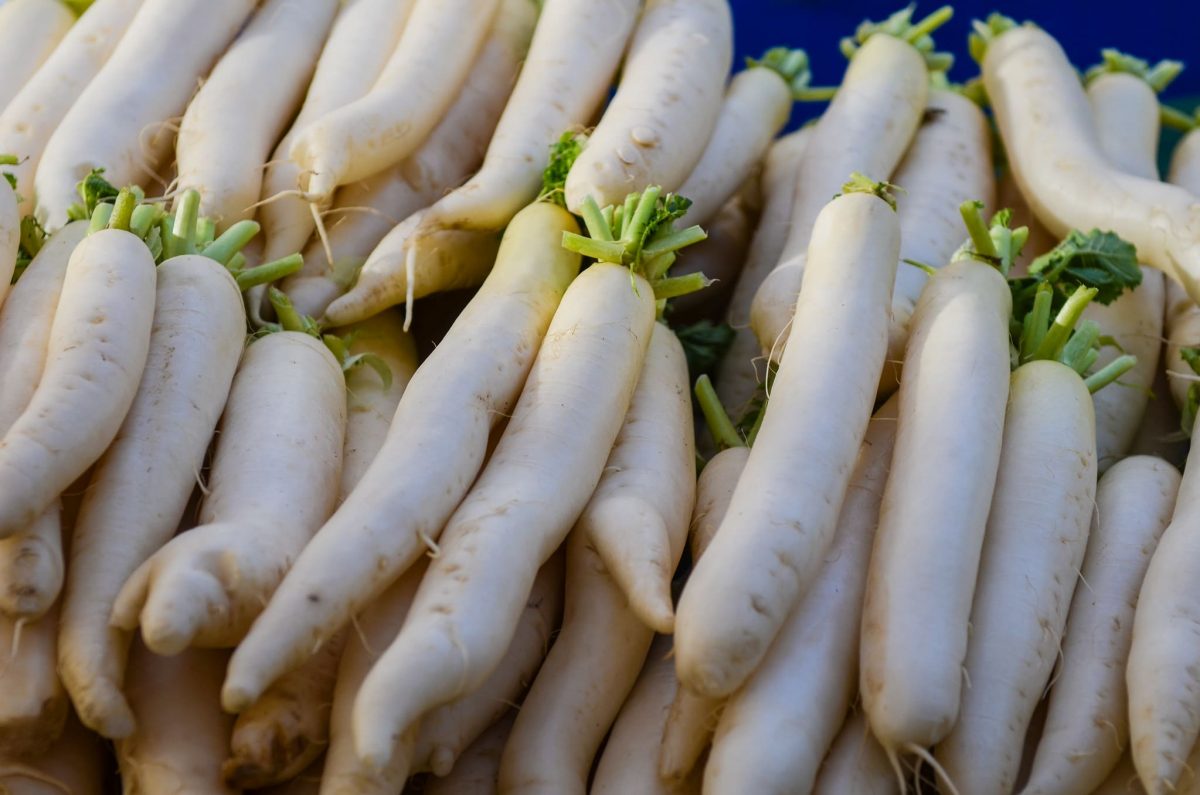If there could be the best replacement for “an apple a day keeps the doctor away”, it’d be the popular Chinese proverb, “eating pungent radish and drinking hot tea lets the starved doctors beg on their knees.”
Radish (Raphanus sativus) is a cruciferous vegetable that originated in Asia and Europe. The small, red radish variety is quite popular in western cuisines. Radish daikon, finds its origin in the Mediterranean regions, is long and white (usually), and popularly used in Indian and Asian cuisines.
The root is cultivated around the world for people as well as livestock. Moreover, its seed oil plays a major role in the cosmetic industry. The benefits of daikon radishes are not only limited to human health and benefits but also extend to land and agriculture. Farmers are often known to plant daikon radishes as a cover crop to improve soil health and increase crop yield.
This article looks at daikon radishes, their history, nutrition and health facts, and culinary uses among others.
Radish daikon (Raphanus sativus var. longipinnatus)goes by many names including mooli, Satsuma radish, Chinese radish, Japanese radish, white radish, and luobo. It is believed to have originated in the Mediterranean regions and is a popular ingredient in Japanese, Chinese, and other Asian cuisines. Daikon is Japanese for “big root.”
It is a low-calorie, high-fiber root that is high in vitamin C, potassium, and phosphorus. Because of its high content of folic acids, it is a great source for pregnant women and lactating mothers. Additionally, its fiber and enzymes aid digestion, detoxification, and its phytonutrients help in the fight against cancer.
Are Radish and Daikon the same?
Both the radishes are closely associated as they share the same genus and species (Raphanus sativus). The one obvious difference between both types is the size. While daikon radishes can grow up to 20 inches long, the regular variety of radishes are quite smaller in size. Moreover, the daikon variety of radishes is often celebrated in cuisines as a palate cleanser deeming to its mild flavor. The regular, small-sized, red radishes are quite sharp and peppery making them a perfect fit for main dishes and salads.
Origin and Look.
A regular radish is a native of Europe, smaller in size with a dark red color. Radish daikon is a large winter white radish that resembles a pale carrot. Its origin lies in Mediterranean and Japanese lands.
Flavour and Consumption.
As a cool-season vegetable, radishes lend a pungent and peppery flavor profile to a meal. They are often consumed raw. Daikon radishes are grown during winters. As their flavor ranges from sweet to mild, they can be pickled or consumed raw.
Storage.
While radishes have a longer shelf life and can be stored for over a week, daikon radishes perish easily unless pickled before storage.
The Leaves.
Daikon radishes, especially the white ones, have bright green leaves. Leaves on the regular variety radish are red at the stems. Although, consuming the leaves is recommended in both the cases considering their multiple nutritional properties.
Daikon Nutritional Facts
Radish daikon is one of those forgotten superfoods that finds its place like an afterthought in a salad or a pickle in most cuisines. It is a shame because daikon has one of the best report cards when it comes to nutritional value.
According to the 2017 study isothiocyanates, which give daikon its peppery quality, were found to help reduce the risk of breast cancer. While enough information is available about the root’s nutritional value, its leaves are a great source of calcium, iron, vitamin A and C.
It is often insinuated that non-vegetarians need to include much more fiber in their diet. Adding radish daikon to the menu may boost the fiber intake. One cup of daikon contains about 2 grams of fiber. Including daikon as a regular ingredient in one’s diet may reduce cardiovascular, digestion, bad cholesterol, and sugar problems. Daikon radishes help keep diabetes in check and aid in maintaining the desired body weight.
100gms of daikon packs the following nutrients:
| Name | Amount | Unit |
| Water | 94.62 | g |
| Protein | 0.6 | g |
| Carbohydrate, by the difference | 4.1 | g |
| Fiber, total dietary | 1.6 | g |
| Calcium, Ca | 27 | mg |
| Vitamin C, total ascorbic acid | 22 | mg |
| Iron, Fe | 0.4 | mg |
| Magnesium, Mg | 16 | mg |
Is Daikon Radish Healthy?
The root is a rich carrier of folic acid. This is particularly important during pregnancy as it helps both the mother and child.
Daikon could also play a crucial role in optimizing your health and well being by:
- Aiding in digestion: Since daikon helps facilitate better digestion of proteins and fats, it helps curb acidity and constipation.
- Boosting immunity: Its antifungal and anti-bacterial properties may help reduce the risk of bone and joint infections, gastroenteritis, meningitis, and pneumonia.
- Assistance in detoxification: Radish daikon helps stimulate urination which results in healthier kidneys and a toxic-free system.
- Strong dietary source: The low calorie, high-fiber content of the root, helps in weight loss and management without causing any adverse effects.
- Lowers cancer risk: Daikon contains phytochemicals and anthocyanins that have anti-carcinogenic properties. It is rich in sulforaphane, which studies have shown has a proven role against breast, colon, prostate, and ovarian cancers.
It is always advisable to consume the entire root (with the leaves) to reap maximum health benefits.
What does daikon radish taste like?

Radishes are known for their unique piquant flavor. Usually peppery with a lingering sweetness, radishes impart an ever so slightly bitter flavor too. What adds to the delectable taste of radishes is its crunchy texture.
The most common white daikon radishes have a mildly sweet, peppery flavor. Eating a daikon radish may feel like eating a dense apple. Other types of daikon range from sweet to hot; their hues play a crucial role as they help to determine the flavor. Black radishes are usually considered to be the hottest, lending the highest bitter aftertaste too.
The myth that long daikon radishes taste hotter is quite untrue. It isn’t the length, but the age. If white daikon radishes are aged, they could taste a lot hotter and peppery on the palate. These could work as a great addition to an Asian main course, but may not be an ideal choice for salads.
Watermelon daikon radishes have the perfect peppery taste to go with mains and appetizers. Those looking for a sweeter option must go for alpines. This small-sized radish daikon variety is the most ideal option for pickles and kimchis.
Can daikon radish be eaten raw?
The white radish daikon variety is quite easy on the palate with its sweet flavor and can be eaten raw. It is often sliced, using mandolins, to add to salads. It can also be chopped into julienne to be added as a garnish (for the extra crunch) to a simple Asian main course dish. While most daikon radishes can be eaten raw, some are particularly used in curries and pot roasts to pack a punch of flavor.
Given the pungency of aged daikon radishes, they are not the most ideal to be consumed in the raw form. These could be added to pickles to bring out their underlying sweet flavor.
Is Daikon the same as white radish?

Although the white, long, “carrot-shaped” variety, with a head of lush green leaves, is the most common and recognizable type, radish daikon comes in different hues and shapes. While the hues help determine the level of sweetness the radish carries, the size usually helps identify shelf life and storage.
Here are some facts about the other varieties of daikon:
Miyashige White. The most common “white daikon” is cylindrical shaped and grows up to 16-18 inches. Its crisp texture and mild flavor make a popular ingredient in Japanese and Indian cuisines.
KN-Bravo. Due to its gorgeous purple skin and light purple to white flesh, this variety adds a lot of color and aesthetics to the plate. It grows up to 6 inches and has a mild sweet flavor.
Alpine. One might as well call it “the kimchi daikon”. The roots grow up to 5-6 inches and it lends a beautiful sweetness to kimchis, salads, and pickles.
Watermelon Radish. Another stunning offer from nature, this one has pale, green skin with a bright pink flesh. It has a spherical shape, and its peppery taste adds the perfect kick to Asian dishes.
Japanese Minowase. This is the most common and largest variety of daikon. These grow up to 24 inches with a sweet flavor and a crunchy texture.
How can you tell if a daikon radish is bad?
The most common method to check a daikon radish is to go for the head. If the head has too many green spots, it indicates that the daikon was exposed to too much sunlight. This means it won’t taste as sweet. The other method is to look at the leaves. Break a leaf to check if it is a fresh luscious green on the inside or a stale white.
Other methods that can help choose good daikon from a bad one are:
- It should have as little bumps as possible
- The daikon should be as white, purple, green (depending on the type) as possible
- Avoid picking radish daikon that has a lot of brown/green spots
- The root must be hard. Avoid daikon radishes that feel soft or spongy
- Any blackened spots, mold, rubbery or wrinkled skin indicate aging or poor handling
- It must not be limp, yellow, or slimy (from anywhere)
How do you clean daikon radishes?
Cleaning a daikon radish is easy and convenient, but needs attention. Like any other root, daikon radish roots carry a lot of mud and dust. Thus, it is crucial to clean and brush them thoroughly before consumption. Always go for daikon radishes that do not have a lot of brown spots or wrinkles. Cut the head of the daikon to detach the leaves for easy cleaning. Rinse it under running water and use a brush to remove mud and dust. Peel off the skin using a chef’s knife or peeler. The daikon is now ready for use.
How do you cut daikon radishes?
Because of its unique flavor, radish daikon can be used in a variety of dishes and cuisines. Methods on cutting daikon vary, depending on the root’s usage in a dish. The first step to cut any daikon radish is to clean it thoroughly and cut the top and bottom half of the root. While the skin on white daikon radishes is usually peeled off, it is not a common practice to do so with other types.
Steps and Styles
The root can be consumed raw after rinsing, peeling, and chopping it into bite sizes.
For salads. Use a mandolin to shave thin rounds of radish daikon for salads. These add a unique pungency to the dish.
For coleslaw. One can also stack shaven thin rounds and use a chef’s knife to get evenly sized matchstick shaped julienne daikon.
For pickles. Cut daikon into one-inch rounds to prepare them for simmering. The shape and size help it absorb the moisture faster to soften up.
For stuffing. Cut the big daikon into half, place a grater on a plate, hold the daikon at a 45-degree angle, and move it back and forth on the grater until you reach the desired amount. Grated daikon can be used as a stuffing in flat-bread or pulped for juices and other drinks.
Using the leaves. If one intends to use the leaves for consumption, it is always advisable to wrap them in a paper before refrigerating. Washing or chopping the leaves before refrigeration leads to faster contamination.
How do you eat daikon radish?
There are umpteen creative recipes that turn this humble root vegetable into a flavor bomb.
Eat them raw. Raw daikon radishes work extremely well in salads and food platters with delectable dips. They can also be used as a replacement for cabbage in coleslaw.
Pickle them. Store in a jar and add these to your kimchi as the Japanese do!
Make healthy parathas/bread. Indians use radish daikon or mooli as a spicy stuffing for their flat-breads. It works as a wonderful breakfast/lunch option owing to its high nutritional value.
Make a coleslaw. Add daikon radishes to your next coleslaw to add more sweetness and mild pungency to your picnic sandwiches.
Vitamin C booster drink. Pairing daikon radish with mangoes and carrot juice adds vitamin C to the dish without changing the flavor! This could be the next health drink.
Make wraps. Every wrap needs a crunchy topping or a side salad. Get rid of those fattening chips and add radishes to your wrap for a health upgrade
Roast them. Adding these radishes to your next pot roast could turn the dish around for good.
Side dish. Steam daikon and drizzle some olive oil, salt, and pepper for a healthy, low-calorie side dish.
Spring rolls. The dish is all about crunch and texture; everything daikon radishes are.
Don’t Throw Those Leaves Away: Apart from their resemblance to carrots and the white color, daikon radishes also stand out because of the luscious green leaves that adorn their heads. These leaves are often discarded while consuming the root. This is a grave mistake. In addition to all the nutritional benefits, the leaves also carry the subtle peppery flavor of the radish. These can be mixed up with other salad leaves or cooked with some oil and garlic as a replacement for wilted spinach.
To Windup
Radish daikon is nature’s gift for the human body. This cruciferous vegetable packs a punch with its low-calorie count, high fibrous properties, strong nutrition count, medicinal properties, brilliant texture, and umami flavor.
Including daikon radishes in your diet will help you maintain your weight and provide protection against cardiovascular conditions and certain cancers.
The incredible versatility of the vegetable makes it easy to prepare and consume.
Have it raw or in your next open sandwich; run along and pick up daikon radishes from the grocery store!
Additional Reading
- Center for Nutrition Policy and Promotion: Dietary Guidelines for Americans, 2010: Chapter 4: Foods and Nutrients to Increase
- Institute of Medicine: Dietary Reference Intakes for Vitamin C, Vitamin E, Selenium, and Carotenoids

5 replies on “In a Nutshell: Eating Radish Daikon”
Very useful and enriching.
Dear Steffi, Extremely amazed reading your article on the importance n nutrition value of Radish daikon. It is well-written and contains very good information .
I Thank you for your thorough research and clear writing….. Waiting for the more!!!!!
Great source of information, I’m convinced and I’ll certainly look for radish next time I buy groceries. Thank you for sharing!
Sachin
V. Nice Information . Congratulation
The article is so informative n well written….. Waiting for the many many more…..